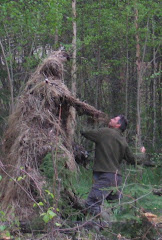

After feeling the pressure from a high profile protest, Victoria's Secret has decided to remedy its reputation. It was feeling guilty for publishing over a quarter of a billion catalogues per year. Well perhaps it wasn't feeling guilty but a few high profile news stories helped it to feign responsibility.
And so, it decided not to reduce its catalogue output, but rather to cancel it's paper supplier's contract. Coincidentally, and my connection to this story is that the paper comes from Alberta, and said trees are replaced by yours truly. In a news conference, Victoria's secret claimed that they were opposed to the demise of Alberta's woodland caribou due to forestry practices by their supplier. A little investigation led me to discover a few pertinent facts.
1) Woodland caribou populations in Alberta have only been studied since 1994
2) In 1995, the boreal forest experienced its most devastating fire season in centuries
3) Uncoincidentally, caribou population declined in the same year and are still recovering.
4) As yet, no statistically relevant data exists on the meta population in Alberta, only heard characteristics.
5) When the data showed that herds were declining (after the 1995 fire) the woodland caribou was placed on the endangered species list in Canada despite no total population data.
6) Scientifically inert city folk with a messiah complex and little understanding of forest mechanics suddenly equate some declining heard populations (many herds were either stable or increasing in Alberta) with forest practices. This transitivity permeates the activist community and voila: Victoria's Secret is now looking for a new paper supplier. Presumably one that doesn't use trees?
Extra Reading
As is often the case with activist notions, there are small kernels of truth that were trampled over in their desperate bid to feel important. There is a study that recently used gps radio collars to track caribou (Dyer et al 2001.)
This study though, is an exercise in problematic research methodology. What the researchers did was to lay out hypothetical roads and seismic lines on a map to see if the tagged caribou crossed actual roads and seismic lines less frequently. In the abstract it seems reasonable, however I could fairly accurately predict the results. The 43,000 data points they collected showed that there was no negative preference for actual seismic lines but by a factor of six, the caribou crossed the imaginary roads over real roads. What's wrong with this data? Nothing. The Conclusion is suspect though for the following reasons:
1) seismic lines are in fact random. They follow straight lines regardless of terrain. Roads on the other hand are not random. They follow high ground since low marshes are expensive to build on. They avoid watercourses, streams, marshes and bogs. Seismic lines are cut and used only in the winter and therefore excused from the constraints of roads.
2) caribou routes like roads but unlike seismic cuts, are not random either. Caribou prefer watercourses, bogs, drainage draws and ephemeral streams. The exact opposite of preferred roadways.
3) since the only random data point is the seismic line, and since a road data point is less likely to be a caribou data point by its very nature, it should come as no surprise that the data shows that caribou do not avoid seismic lines but do avoid roads.
4) This study, often quoted in many other studies, was used to demonstrate that any man-made disturbance impacted caribou. This by extension after several retelling translates into declining populations. All of this in spite of the fact that in 1995 mother nature reeked more temporary havoc than man ever could. Incidentally, 3 years later, I was evacuated from a fire in northern Alberta in 1998 that consumed more timber than had been logged in all of Alberta for the last 7 years.



2 comments:
Silly humans - always at the center of the universe one way or another.
I know nothing of reindeer.
Then again, I do not have to because I am emminently practical and logical (much like yourself) and can therefore comment thoughtfully.
Many urban people know nothing of reindeer but are illogical and impractical and therefore ridiculous situations arise. I make it my business to profit from this idiocy. I am an arbitrageur of idiocy.
But let us consider at this Yuletide, the reindeer, Rangifer tarandus. The 10 percenters likely view them as cute and fluffy, pulling sleighs and living, as pets, happily with idyllic families of Lapps.
The reality, I suspect, is a beast of no intellectual capacity that knows nothing but cold, pain and fear who's only real purpose is as a protein converter for bears, wolves, Eskimaux and Finns. I imagine that they smell, are infested with flies, ticks and diseases.
The consumption of reindeer makes one highly eccentric and very grumpy. To prove this assertion, may I present the Finns. Are your Eskimaux endlessly irritating?
Furthermore, tell these underwear wearers that there are plenty of trees in Canada. If the reindeer's tree dies, burns, drowns, dries out, is eaten, or is cut down not to worry. The reindeer will find another tree.
Cheers and Good Mental Health
Post a Comment